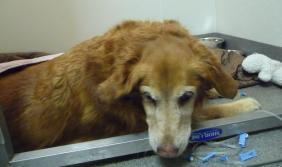How Do I Know if My Pet is in Pain?
- posted: Aug. 28, 2016
 Recognizing Pain in Animals
Recognizing Pain in Animals
At Patton Veterinary Hospital, we are asked this question a lot: Is my pet in pain? No one wants their pet to suffer, but our dogs and cats and other critters cannot talk to us, and sometimes it is difficult to know what they might be feeling. It is our duty as veterinarians and as pet owners to be advocates for our pets and to make them comfortable when they hurt. But how do we know if they are painful?
Recognizing pain in animals can be tricky. First of all, they are creatures of instinct, and some of those wild traits remain even in our domesticated pets. It is ingrained in most animals to hide pain. If an animal displays signs of pain, it would surely spell disaster in the wild. So, just because a dog, cat or other animal is not crying out or whimpering, it does not mean he or she is not in pain. Individuals also have different tolerance levels for pain. Some pets tolerate extreme pain and show very few signs such as the Lab who is still wagging his tail and trying to walk with a broken leg. Others may be much less tolerant and may yelp when a broken toenail is touched. It depends on the individual as well as the type of injury.
Older dogs and cats with arthritis often struggle to get up or will limp, but are not usually whining or meowing. Despite lameness and difficulty moving, many owners do not realize that they are in some degree of pain. It would be the rare person who has never experienced any kind of pain in his or her life. If you are in severe pain, you might scream or cry. But with other types of pain such as a headache or sprained ankle, most of us don’t walk around whining or crying about it. It is the same with our pets. Dogs or cats who are limping ARE in pain. They can cope with it, but it hurts. Luckily, there are many ways both medical and non-medical to alleviate pain in pets.
It can be extremely difficult to discern when cats are in pain. A painful cat will often hide or sit hunched with the legs under the chest and with her eyes closed. Both dogs and cats may have a decreased appetite, may hide in strange places or may become more “clingy” constantly following their owners if they are in pain. Panting, wincing when touched, and having the eyes half closed can also be signs of pain, though there are obviously many other reasons that these signs may occur. Licking or chewing at a focal area may also indicate pain. Some animals will also display uncharacteristic aggression if they are hurt, so, be extremely cautious if you are trying to handle or move a pet, especially if a severe injury like a broken bone is suspected. Birds, small mammals and reptiles also experience pain but are even more likely to hide their pain and will often become quiet and withdrawn.
Pain management has come a long way in both veterinary and human medicine, and we are much better at recognizing, preventing and treating pain in our companion animals. That being said please do not give any medications to your pets without consulting a veterinarian first. Some drugs such as Tylenol can be extremely toxic and even fatal to cats, and other drugs may cause side effects or have much different dosing than would be experienced in people. If your pet is showing any of the described signs of pain, or if you are concerned that your pet may be in pain for any reason, please consult your veterinarian. There are many ways we can keep your pet happy and comfortable, even many of those with chronic pain. No pet deserves to hurt. Be a champion for your pet and stop the pain.
This blog brought to you by the Patton Veterinary Hospital serving Red Lion, York and the surrounding communities.
Photo from flickr.com
Location
Patton Veterinary Hospital
425 E Broadway
Red Lion, PA 17356
